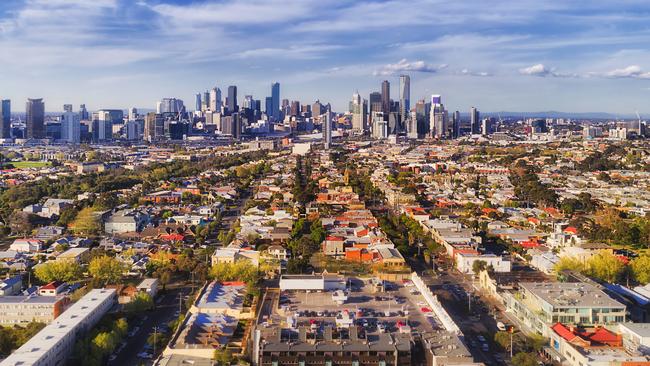Property investors face double hit with land tax, super tax
Property investors are facing an unprecedented double taxation on imaginary profits thanks to the combination of the new super tax and state-based schemes.

Property investors are suddenly in the frame in a new tax onslaught.
The pressure is coming from two fronts. A new super tax from Canberra, which will hit property investors hardest, and steeply rising land taxes from the states.
Worse still, this looming tax squeeze on property investors is based on a notoriously unproductive tax weapon – unrealised gains. That’s gains made on paper only.
Land tax at state level has been a millstone for investors for decades.
Paying upfront for the unimproved value of land is effectively a tax on unrealised gains, which is why it is so unpopular.
But it’s exceptionally lucrative for the states.
In Victoria, the biggest exploiter of land tax in the country, the dollars collected on the tax have more than tripled over the last decade while house prices in the state grew by less than 70 per cent.
The outcome?
Investors have fled Melbourne’s residential market and Melbourne has the weakest price growth among all major cities.
Land tax in Melbourne cuts in at a lower level than any other state capital, which means investors in the city pay the most tax. In fact, Victoria now has 10 separate taxes aimed at investors.
Residential investors are now much more likely to shop around between states and the tax bills they will face is a swing factor, which is a key reason why Queensland is the hottest property market nationwide.
The problem now for investors all over the country is that the new super tax, also based on unrealised gains, is going to arrive on top of state-based land taxes.
Property is the sitting duck for this new unindexed super tax because it is calculated based on changes of value each year.
And in the very same way that land tax increases are infuriating to the holder of land who has not realised any profits, the new super tax will create tax increases on the holder of land held inside super funds that have not realised any actual gains.
So-called liquid assets such as shares can be easily manipulated to ensure investors sit on the right side of the line where it comes to the new super tax threshold, which is to be imposed on earnings on amounts above $3m from July 1 this year.
In contrast property assets are illiquid. You can’t sell, say, a $20,000 portion of a $500,000 property to avoid entering the tax bracket for the new tax known as Division 296.
That does not mean investors won’t try. As industry research suggests, there will be a fourfold increase in liquidity problems with the new tax.
And it’s not like the Australian Tax Office will be oblivious to it all. In fact, the ATO is already more than familiar with games around property valuations in super funds.
A recent report from TSP Accountants noted that ATO data analysis showed more than 16,500 self managed superannuation funds (SMSFs) reported assets having the same value for three consecutive years.
“With many of these assets residential or commercial Australian property, you can forgive the ATO for being incredulous,” the report noted.
And keep in mind, that is what’s being going on before the new super tax hit the headlines.
It will only get worse.
The Perth-based auditor who has alerted the investment community to the surprise hit to franked dividends from the new tax, Reliance Auditing Services’ Naz Randeria, says double taxation is looming.
“If your SMSF owns property, you’ll now be taxed on its unimproved land value every year via land tax, and again on its rising overall value via this new super tax before you’ve sold a single brick. That’s double taxation on imaginary profits.”
What might this do to a market where conditions for property investment was looking ideal.
Falling interest rates and tight demand are set to underpin sold price rises over the next two years.
But for investors the issue is whether they can make money, after tax, under current conditions.
For investors using SMSFs to hold commercial property or farms the new tax is a headache.
But for those holding residential property, and there is at least $50bn in this sector, it looks like death by a thousand cuts.
Financing for residential property in super has narrowed dramatically as the major banks quit the market leaving SMSF property investors paying the highest mortgage rates in the market.
Investment and property advisers are now fully stretched attempting to explain to investors how the new tax will work. They need to move quickly because the baseline for new tax starts on July 1.
As financial adviser James Gerrard has pointed out, there are misconceptions around the new super tax. It only applies on the proportion of earnings attributable to the part of an individual’s total super balance that exceeds $3m.
And that’s all very well. But the issue is not so much it’s a new tax, or whether people should have $3m in super or not. It’s about the taxing of paper gains.
Politically, Treasurer Jim Chalmers is in a powerful position. Freshly re-elected he does not just have support for the new tax in parliament, he has support from the Greens to bring the threshold for the tax down from $3m to $2m.
But the biggest question is where does the move to taxing unrealised gains end.
First land tax, then super tax. What comes next?





To join the conversation, please log in. Don't have an account? Register
Join the conversation, you are commenting as Logout